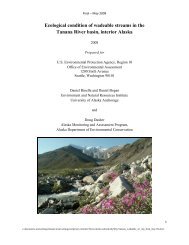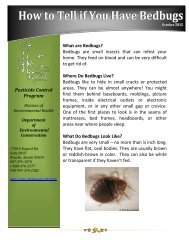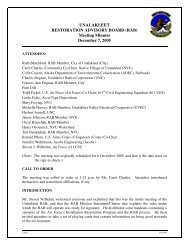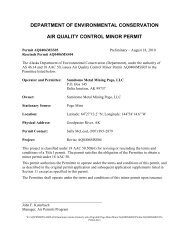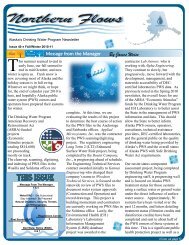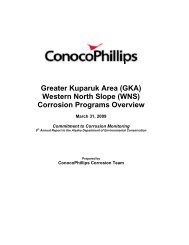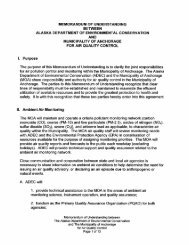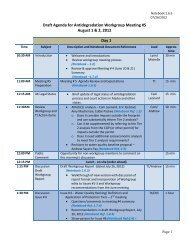2012 Ocean Ranger Guidebook Revision 3-7-12 - Alaska ...
2012 Ocean Ranger Guidebook Revision 3-7-12 - Alaska ...
2012 Ocean Ranger Guidebook Revision 3-7-12 - Alaska ...
You also want an ePaper? Increase the reach of your titles
YUMPU automatically turns print PDFs into web optimized ePapers that Google loves.
<strong>20<strong>12</strong></strong> <strong>Ocean</strong> <strong>Ranger</strong> <strong>Guidebook</strong> 3-7-<strong>12</strong><br />
Although this citation is for ships over 500 passengers, there are identical VGP citations for ships with<br />
100 to 500 passengers.<br />
What to check for: Check for discharges of pool and spa wateroverbaord within 3nm. If discharges occur<br />
check that they were dechlorinated and debrominated, and if these levels were measured as required. If<br />
pool or spa water was discharged into the wastewater system, check that chlorine is monitored and<br />
below ADEC GP levels.<br />
Note: Discharges of pool and spa water are prohibited in national parks, federal wilderness areas,<br />
national wildlife refuges, marine sanctuaries, and national wild and scenic rivers. The largest prohibited<br />
area of interest would likely be Glacier Bay National Park. Because many of these areas have boundaries<br />
that are difficult to determine, please note the position on your report so that ADEC can determine if<br />
the location is in a prohibited area. Many National Parks and wilderness areas only include lands above<br />
the high tide line, although some do include state waters.<br />
Citations:<br />
EPA VGP 5.1.1.2 Pool and Spa Discharges<br />
Discharges of pool or spa water are not authorized into waters listed in Part <strong>12</strong>.1 of this permit.<br />
Discharges from pools and spas are authorized into other waters subject to this permit, provided they are<br />
dechlorinated and/or debrominated, and discharged while the vessel is underway. To be considered<br />
dechlorinated, the total residual chlorine in the pool or spa effluent must be less than 100μg/l if the pool or spa<br />
water is discharged without treatment through an advanced wastewater treatment system. To be considered<br />
debrominated, the total residual oxidant in the pool or spa effluent must be below 25μg/l if the pool or spa<br />
water is discharged without going through an advanced wastewater treatment system. Pool and spa water may<br />
be added to the graywater treatment systems, however any resultant discharge must meet all standards and<br />
requirements found in Part 5.1.1.1 and must be debrominated.<br />
EPA VGP 5.1.2.3 Treated Pool and Spa Discharges<br />
Vessel owner/operators must monitor chlorine or bromine concentrations (as applicable) in pool or spa<br />
water before every discharge event using Part 136 methods if they will discharge these streams directly into<br />
waters subject to this permit to assure that the dechlorination process is complete. If vessel owner/operators are<br />
monitoring bromine concentrations, they may use a field test kit which uses the colorimetric method in lieu of Part<br />
136 methods to assure waters have been debrominated, provided that test kit has method detection limit no<br />
higher than 50 μg/L. You must record the location of the discharge, the estimated volume of the discharge, and the<br />
concentration of chlorine or bromine (as applicable). Records of this monitoring must be kept with other graywater<br />
monitoring records.<br />
For chlorine, analytical results below the method detection limit shall be deemed compliant with the<br />
effluent limits, provided the permittee uses a testing method with a detection limit no higher than 10.0 μg/L<br />
under ideal conditions. EPA recommends method SM4500-CL G (DPD Colorimetric Method) for these purposes<br />
as it is able to reach 10 μg/L under ideal conditions and so meets these requirements. SM4500-Cl G is typically<br />
the method that ADEC/USCG uses for compliance monitoring. For bromine, analytical results below the method<br />
detection limit shall be deemed compliant with the effluent limits, provided the permittee uses a testing method<br />
with a detection limit no higher than 50.0 μg/L.<br />
Note- EPA VGP 5.2.2.3 is identical, except that it applies to large cruise ships under 500 passengers.<br />
186






